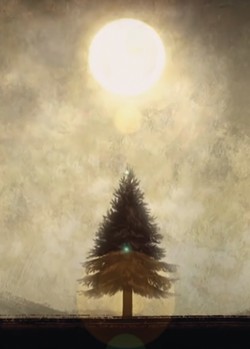[
{
"name": "500x250 Ad",
"insertPoint": "5",
"component": "15667920",
"parentWrapperClass": "",
"requiredCountToDisplay": "1"
}
]
Local Indigenous nations have several traditional stories about what periodically made the sun disappear for several minutes during the daytime. Those tales will be shared during a celebration and viewing of the eclipse on Monday, April 8 at Fort Hill near Ganondagan State Historic Site (Ganondagan itself is reserved for a private event that day).
“We're going to talk a little bit about the stories and then have a chance to discuss the scientific implications of celestial events that people in western New York would have seen historically,” said Michael Galban (Mono Lake Paiute/Washoe), director of Ganondagan and the Seneca Art & Culture Center.
Among regional eclipse stories, one stands out. According to oral history, the sky darkened in a total solar eclipse during the formation of the Haudenosaunee Confederacy, which is the oldest living democracy in North America — and possibly the world.
“The confederacy was formed pre-European contact,” said cultural interpreter at Ganondagan Allie Hargrave (Oneida). “One version of the story, which is a pretty well-accepted one, has the actual creation of the government happening under a total solar eclipse.”
The year was 1142 — maybe. Because of the nature of oral traditions, it’s hard to pin down exactly which eclipse was the one that coincided with the ratification council that convened at the hilltop Seneca village of Ganondagan, which is near present-day Victor.
“A significant part of the narrative relates to the eclipse,” Galban said. “In a lot of ways that eclipse was evidence for the Seneca people that the message of The Peacemaker, which they call The Great Law of Peace, was true and worthwhile and should be listened to.”
The confederacy was originally made up of five nations: the Mohawk, Oneida, Onondaga, Cayuga, and Seneca gathered to form an alliance of lasting peace among the people. The sixth nation, the Tuscarora, joined the confederacy in the early 18th century.
It was long believed that the confederacy was founded in the 15th or 16th century, but University of Toledo researchers Barbara A. Mann and Jerry L. Fields challenged that in their 1997 paper in the “American Indian Culture and Research Journal,” which stated the eclipse that likely marked the confederacy’s formation happened on August 22, 1142, as Ganondagan, where the ratification council took place, was in the path of totality for that eclipse.
“The eclipse gives us an opportunity to have a conversation about what Haudenosaunee people created — a lasting and peaceful Confederacy, which exists until this day,” Galban said. “We want to use this moment to talk about what peace looks like from a Haudenosaunee perspective: not simply the absence of war, it's a relationship that has to be fostered and tended to year in and year out.”
Following the eclipse on April 8, visitors to Fort Hill are encouraged to stick around for a fire, traditional games, and other activities. ganondagan.org
Rebecca Rafferty is a contributor to CITY.
“We're going to talk a little bit about the stories and then have a chance to discuss the scientific implications of celestial events that people in western New York would have seen historically,” said Michael Galban (Mono Lake Paiute/Washoe), director of Ganondagan and the Seneca Art & Culture Center.
Among regional eclipse stories, one stands out. According to oral history, the sky darkened in a total solar eclipse during the formation of the Haudenosaunee Confederacy, which is the oldest living democracy in North America — and possibly the world.
“The confederacy was formed pre-European contact,” said cultural interpreter at Ganondagan Allie Hargrave (Oneida). “One version of the story, which is a pretty well-accepted one, has the actual creation of the government happening under a total solar eclipse.”
The year was 1142 — maybe. Because of the nature of oral traditions, it’s hard to pin down exactly which eclipse was the one that coincided with the ratification council that convened at the hilltop Seneca village of Ganondagan, which is near present-day Victor.
“A significant part of the narrative relates to the eclipse,” Galban said. “In a lot of ways that eclipse was evidence for the Seneca people that the message of The Peacemaker, which they call The Great Law of Peace, was true and worthwhile and should be listened to.”
The confederacy was originally made up of five nations: the Mohawk, Oneida, Onondaga, Cayuga, and Seneca gathered to form an alliance of lasting peace among the people. The sixth nation, the Tuscarora, joined the confederacy in the early 18th century.
It was long believed that the confederacy was founded in the 15th or 16th century, but University of Toledo researchers Barbara A. Mann and Jerry L. Fields challenged that in their 1997 paper in the “American Indian Culture and Research Journal,” which stated the eclipse that likely marked the confederacy’s formation happened on August 22, 1142, as Ganondagan, where the ratification council took place, was in the path of totality for that eclipse.
“The eclipse gives us an opportunity to have a conversation about what Haudenosaunee people created — a lasting and peaceful Confederacy, which exists until this day,” Galban said. “We want to use this moment to talk about what peace looks like from a Haudenosaunee perspective: not simply the absence of war, it's a relationship that has to be fostered and tended to year in and year out.”
Following the eclipse on April 8, visitors to Fort Hill are encouraged to stick around for a fire, traditional games, and other activities. ganondagan.org
Rebecca Rafferty is a contributor to CITY.
Latest in Culture
More by Rebecca Rafferty
-

Partnership perks: Public Provisions @ Flour City Bread
Feb 24, 2024 -

Raison d’Art
Feb 19, 2024 -

Partnership perks | Winter Swan Coffee + Stacy K Floral
Feb 9, 2024 - More »





